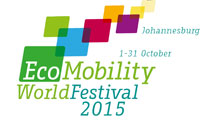[[{"type":"media","view_mode":"media_large","fid":"411539","attributes":{"alt":"MEC Ismail Vadi","class":"media-image","id":"1","style":"margin-left: 3px; margin-right: 3px; float: left;","typeof":"foaf:Image"}}]]By Ismail Vadi
Since the start of October the distinctive sound of cars on Sandton’s busy streets has been replaced by the purring sound of bicycle tyres and the constant chatter of commuters in motion. The change in the character of Sandton has been most noticeable with the usual hustle and bustle of vehicles replaced by a gentler sea of moving people.
The month-long EcoMobility World Festival in October was conceptualised to showcase a future transport system where public transport, walking and cycling become the modes of choice.
Most of our large cities have severe traffic congestion at the morning and afternoon peaks as many people use their cars to commute. It is estimated that over 100 000 people travel through Sandton every day.
Untold productive hours are lost yearly due to congestion, while large volumes of traffic take a toll on our road infrastructure. Our environment is also impacted by greenhouse gas emissions from private vehicles.
A less obvious and yet utterly apparent consequence of high volumes of vehicle traffic is the loss in social interaction. The thousands of motorists seated in their cars, most often alone rarely find time to interact with their environment or other people.
The EcoMobility World Festival provides a preview of an alternate reality by turning congested metal filled streets into public spaces, resplendent with the buzz and vibrancy of human interaction.
The verdict is still out on whether this is the start of a long term trend or if people will simply get back into their cars at the end of the month. What is indisputable is that it has inspired people to think differently about mobility and has shown that public transport can and does work, and that options such as cycling or walking are valid alternatives.
Government will work towards better and more reliable public transport. Government has in the past invested billions on rail and transport infrastructure and plans are in place to ramp up spending on infrastructure over the next 20 years. We are confident that investments in our Rail Rolling Stock Programme and various Bus Rapid Transport Systems will change the face of public transport in South Africa.
Ultimately our vision is of an integrated transport system that connects communities and powers mobility. Every new road we build or upgrade, every option that improves public transport, be it bus, rail, bicycle or pedestrian ensures that we empower communities to change their lives by providing efficient and reliable transport infrastructure.
Our efforts are guided by the National Development Plan (NDP) which states that by 2030 investments in the transport sector will:
- Bridge geographic distances affordably, reliably and safely so that all South Africans can access previously inaccessible economic opportunities, social spaces and services; and
- Support economic development by allowing the transport of goods from points of production to where they are consumed. This will also facilitate regional and international trade.
In simple terms the NDP vision points to a future where transport becomes the heartbeat of the economy. It speaks of a future where transport and its infrastructure plays a central role in advancing economic growth and reducing historic inequalities.
A major part of this drive is to break down the artificial spatial divides that were created under apartheid. We still live with a legacy where many people live far from their places of work, however we have been actively working to change this. Our investments in infrastructure are creating integrated transport networks that allow people to access economic opportunities and their places of work more easily.
A case in point is the walk-way bridge that is being constructed at Grayston drive in Sandton to provide access for the estimated 10 000 pedestrians who cross the Grayston off ramp from Alexandra to Sandton and vice versa daily.
This construction area was the scene of a tragic incident recently when the bridge carry structure collapsed claiming the lives of two people and injuring several others.
I wish to convey my sincere and heartfelt condolences to the families of the people who died, and wish a speedy recovery for those who sustained injuries.
I am confident that the authorities will leave no stone unturned to determine the cause of this tragedy and will implement appropriate action to ensure that such tragedies do not occur again.
An incident like this brings into sharp focus the need for better and more modern transport infrastructure. Therefore our existing transport infrastructure must be constantly upgraded or renewed to meet the needs of a fast growing economy.
Government is confident that our investments in transport infrastructure will in time change the country’s landscape and further position us as an attractive investment destination.
We invite all South Africans to join us on this journey as we strive to create world class cities with effective, efficient and safe public transport. Together we can become the change that we want to see.
Ismail Vadi is MEC for Roads and Transport: Gauteng Provincial Government





